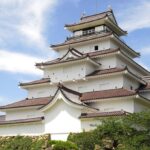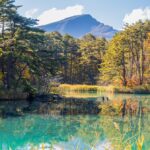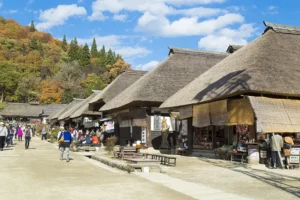
Hidden in the mountains of Fukushima Prefecture, Ōuchi-juku (大内宿) is a beautifully preserved Edo-period post town that transports visitors back to the days when samurai, merchants, and travelers journeyed along the ancient roads of Japan. With its thatched-roof houses, dirt roads, and surrounding countryside, Ōuchi-juku offers a rare glimpse of old Japan untouched by time — one of the country’s most picturesque and culturally significant destinations.
Contents
A Historic Stop on the Aizu Nishi Kaidō

Ōuchi-juku was originally founded in the 17th century as a post town (shukuba) along the Aizu Nishi Kaidō, a vital trade route connecting Aizu-Wakamatsu and Nikkō during the Edo period. Travelers, officials, and samurai would stop here to rest, eat, and lodge on their journeys between regions.
While many such towns disappeared with modernization, Ōuchi-juku survived remarkably intact. Today, it is carefully protected as an Important Preservation District for Groups of Traditional Buildings, offering a living museum of Japan’s travel culture.
The Scenery: Edo Japan Frozen in Time
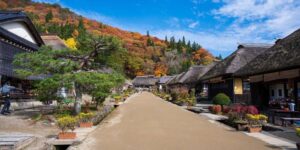
Walking through Ōuchi-juku feels like stepping into a painting. The main street, stretching about 500 meters, is lined with dozens of thatched-roof houses (kayabuki), many over 300 years old. There are no utility poles or modern signs, preserving the town’s historical integrity.
The buildings now serve as restaurants, souvenir shops, guesthouses, and museums, but the traditional architecture and atmosphere remain unchanged. The backdrop of forested hills and clear mountain air enhances the sense of tranquility — especially when snow blankets the roofs in winter or cherry blossoms bloom in spring.
At the end of the main street, a short climb up a hillside path offers a panoramic view of the entire town — one of the most photographed spots in Fukushima Prefecture.
Traditional Local Cuisine
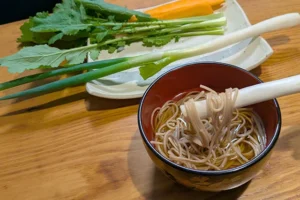
Ōuchi-juku is famous for its simple yet distinctive Edo-style cuisine, reflecting the rural life of travelers from centuries past.
-
Negi Soba (ねぎそば) – The most iconic dish. Buckwheat noodles are served in a hot broth, eaten using a long green onion instead of chopsticks! This unique experience is both fun and symbolic of the area’s humor and hospitality.
-
Tochi-mochi (とち餅) – A traditional rice cake made with horse chestnut flour, slightly bitter and nutty in flavor.
-
Charcoal-grilled river fish (ayu) – Freshly caught and grilled on skewers over open fires.
-
Local sake and pickles – Produced using clear mountain water and time-honored methods.
Eating at a traditional thatched-roof restaurant while watching smoke rise from the hearth gives a true taste of Edo-era simplicity.
Festivals and Seasonal Beauty
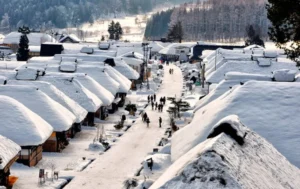
Ōuchi-juku’s charm changes dramatically with the seasons:
-
Spring: Cherry blossoms and young greenery bring fresh life to the village.
-
Summer: The thatched roofs are framed by bright blue skies and lush mountains.
-
Autumn: Fiery red and gold foliage surrounds the town — a photographer’s dream.
-
Winter: Deep snow covers the rooftops, and warm lanterns glow in the twilight.
The highlight of the year is the Ōuchi-juku Snow Festival (大内宿雪まつり) in February, when the village is illuminated by hundreds of snow lanterns and candles, creating a magical, almost otherworldly atmosphere. Fireworks light up the sky above the snowy thatched houses — a truly unforgettable sight.
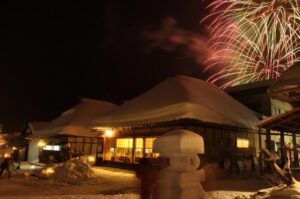
Cultural Experiences and Attractions
While strolling through the village, visitors can enjoy:
-
Old Post Station Museum (Ouchi-juku Honjin): Learn how travelers were hosted during the Edo period.
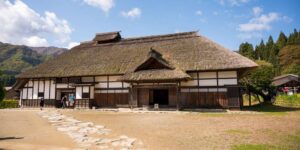
-
Handicraft Workshops: Try your hand at making soba noodles, straw sandals, or traditional crafts.
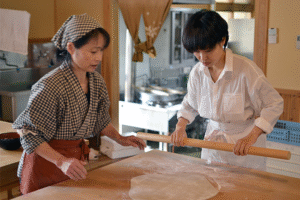
-
Shrines and Temples: Small local shrines offer peaceful places for reflection and scenic photos.
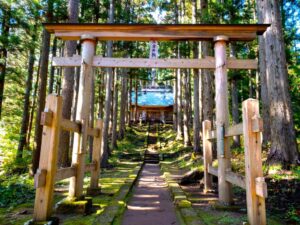
-
Kimono Rentals: Dress in Edo-style kimono and take photos along the old street — a favorite among foreign visitors.
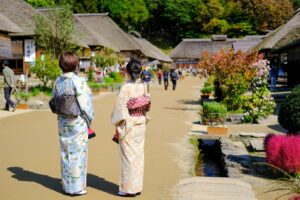
Accommodation
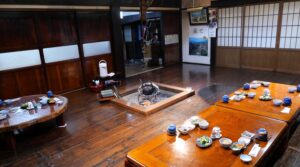
Several thatched-roof inns (minshuku) still accept overnight guests, allowing visitors to experience traditional Japanese country hospitality. Guests sleep on futons, dine on home-cooked regional meals, and bathe in natural hot spring water.
At night, the village becomes quiet and serene — the sound of the river and the glow of oil lamps recreate a truly timeless atmosphere.
Access
By Train and Bus:
-
From Tokyo, take the Tohoku Shinkansen to Aizu-Wakamatsu Station (about 3 hours).
-
Transfer to the Aizu Railway and get off at Yunokami Onsen Station (approx. 40 minutes).
-
From there, a local bus or taxi takes about 15 minutes to reach Ōuchi-juku.
By Car:
-
Around 30 minutes from Aizu-Wakamatsu City.
-
Parking available near the village entrance (visitors must walk through the main street on foot).
Practical Information
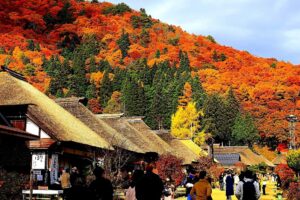
-
Location: Shimogō Town, Minamiaizu District, Fukushima Prefecture
-
Admission: Free (small entry fees apply for certain museums)
-
Best Seasons: Winter (for snow scenes) and autumn (for fall colors)
-
Dining Hours: Most restaurants open between 10:00 a.m. and 4:00 p.m.
-
Wi-Fi: Available in some shops and cafés, but mobile signal may be weak in parts of the village
A Living Window into Japan’s Past
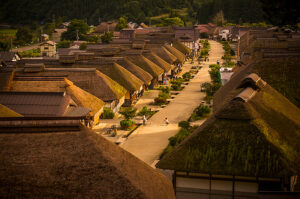
Ōuchi-juku is more than a sightseeing spot — it’s a living heritage village that preserves the essence of Edo Japan. Every thatched roof, cobblestone step, and bowl of soba tells a story of resilience and tradition.
For travelers seeking the “real Japan”, far from neon lights and high-rises, Ōuchi-juku offers an unforgettable journey into a simpler, slower world — where history, nature, and community come together in perfect harmony.
As you stroll down its peaceful street, warmed by the scent of wood smoke and the echo of clogs on earth, you may feel, just for a moment, as if you’ve slipped through time itself.
Related articles
Official Website
https://fukushima.travel/destination/ouchi-juku/11
Accommodation sites
Agoda
